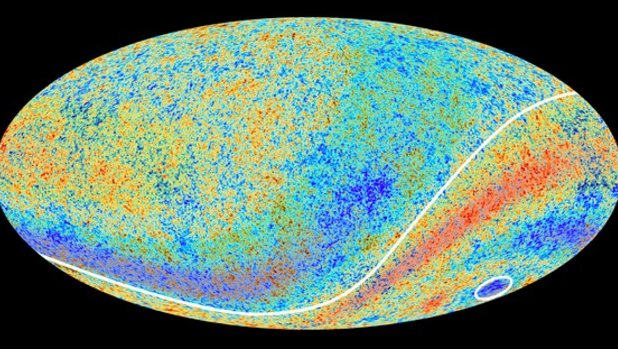Plank map of the universe shows asymmetrical distribution of temperatures and a puzzling cold spot. Credit: ESA
PARIS, March 21 (UPI) -- The most detailed map of the signature radiation the big bang ever created could challenge current understanding of the universe, European scientists say.
The map created from the initial 15 months of data from the European Space Agency's Planck space telescope is the mission's first all-sky picture of the oldest light in the universe when it was just 380,000 years old, the ESA reported Thursday.
A hot dense soup of protons, electrons and photons at about 4,900 degrees F made up the early universe, and it was only when the protons and electrons joined to form hydrogen atoms that the light was set free, scientist said.
The light has been stretched out to microwave wavelengths, equivalent to a temperature of just a few degrees above absolute zero.
Regions of slightly different densities at very early times, indicated by tiny temperature variations, represent the seeds of the future structure of the universe, allowing cosmologists to determine the composition and evolution of the Universe from its birth to the present day.
While the Planck telescope map provides confirmation of the standard model of cosmology, its high precision also reveals peculiar unexplained features that may well require new physics to be understood, scientists said.
One is an unexpected asymmetry in the average temperatures on opposite hemispheres of the sky, which brings into question predictions of the standard model that the universe should generally look the same in any direction from which it observed.
Also, there is a cold spot that extends over a patch of sky much larger than expected, researchers said.
"The fact that Planck has made such a significant detection of these anomalies erases any doubts about their reality; it can no longer be said that they are artifacts of the measurements," Paolo Natoli of the University of Ferrara in Italy said. "They are real and we have to look for a credible explanation."
The anomalies could suggest the universe is in fact not the same in all directions on a larger scale than can be presently observed, some scientists say.
"Our ultimate goal would be to construct a new model that predicts the anomalies and links them together," George Efstathiou of Britain's Cambridge University said. "But these are early days; so far, we don't know whether this is possible and what type of new physics might be needed.
"And that's exciting."















